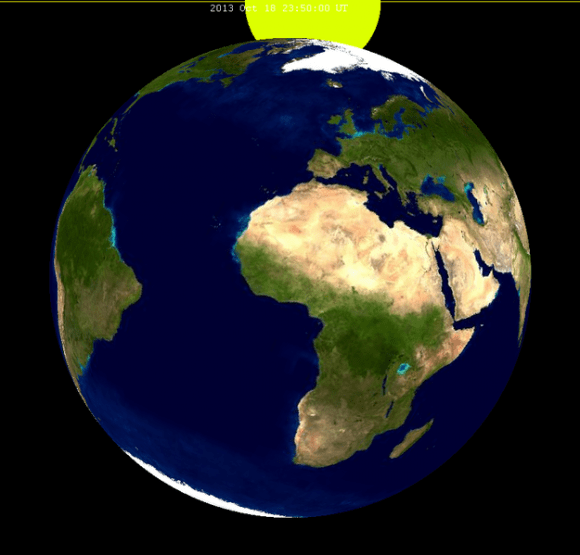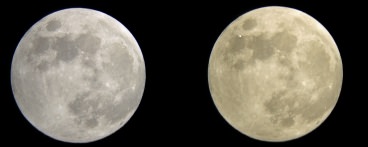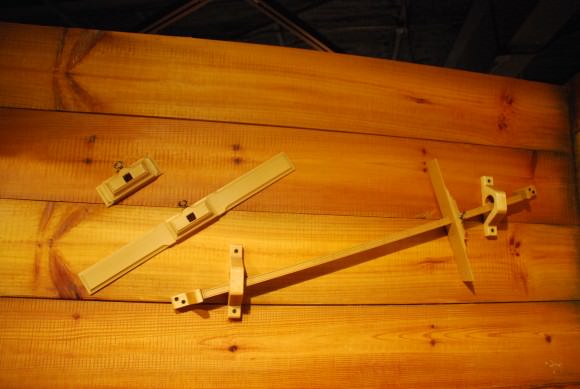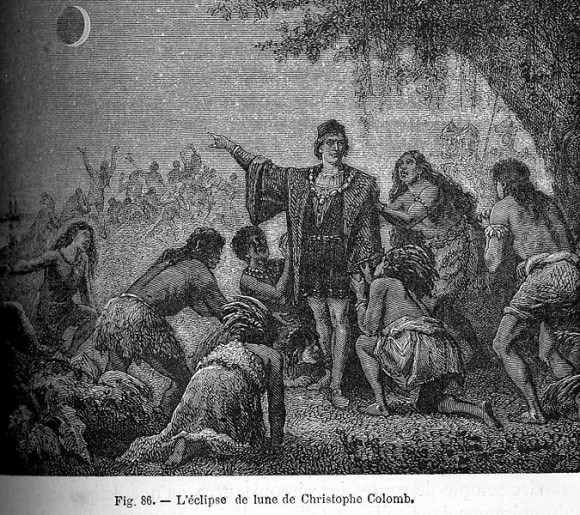You can always count on an eclipse to get you out of a delicate situation. Today is Columbus Day in the United States and Thanksgiving north of the border in Canada. Later this week also marks the start of the second eclipse season for 2013. Today, we thought we’d take a look at the circumstances for the first eclipse of the season kicking off this coming Friday night, October 18, as well as the fascinating role that eclipses played in the life and times of Christopher Columbus.
Friday’s event is a penumbral lunar eclipse, meaning that the Full Moon will only pass through the outer bright rim of the Earth’s shadow. Such events are subtle affairs, as opposed to total and partial lunar eclipses, which occur when the Moon enters the dark inner core, or umbra, of the Earth’s shadow. Still, you may just be able to notice a slight dusky shading on the lower southern limb of the Moon as it flirts with the umbra, barely missing it around the time of central eclipse at 23:51 Universal Time/ 7:51 PM Eastern Daylight Saving Time. Friday night’s penumbral is 3 hours and 59 minutes in duration, and 76.5% of the disk of the Moon will be immersed in the penumbra at maximum eclipse.

Key Events occurring on Friday, October 18th:
21:50UT/5:50PM EDT: 1st contact with the Earth’s shadow.
23:51UT/7:51PM EDT: Mid-eclipse.
01:49UT(Oct 19th)/9:49PM EDT: Last contact. Eclipse ends.
The eclipse will be underway at moonrise for North and South America and occur at moonset for central Asia— Africa and Europe will see the entire eclipse. Standing on Earth’s Moon, an observer on the nearside would see a partial solar eclipse.

This eclipse is the 3rd and final lunar eclipse of 2013, and the 5th overall. It’s also the first in a series of four descending node eclipses, including the total lunar eclipse of October 8th next year. It’s also the 52nd eclipse of 72 in the lunar saros series 117, which started on April 3rd, 1094 and will end with a final lunar eclipse on May 15th, 2356. Saros 117 produced its last total lunar eclipse in 1815 and its final partial in 1941.
Though penumbrals are slight events, we’ve been able to notice an appreciable difference before, during and after the eclipse photographically:

Be sure to use identical exposure settings to catch this effect. Locations where the Moon rides high in the sky also stand the best chance of imaging the faint penumbral shading, as the Moon will be above the discoloring effects of the thicker air mass low to the horizon.
The Moon reaches descending node along the ecliptic about 20 hours after the end of the eclipse, and reaches apogee just over six days later on October 25th. The October Full Moon is also known as the Hunter’s Moon, providing a bit of extra illumination on the Fall hunt.
And this sets us up for the second eclipse of the season the next time the Moon crosses an ecliptic node, a hybrid (annular-total) solar eclipse spanning the Atlantic and Africa on November 3rd. More to come on that big ticket event soon!
In Columbus’s day, the Moon was often used to get a rough fix of a ship’s longitude at sea. Columbus was especially intrigued with the idea of using lunar eclipses to determine longitude. If you can note the position of the Moon in the sky from one location versus a known longitude during an event— such as first contact of the Moon with the Earth’s umbra during an eclipse —you can gauge your relative longitude east or west of the point. The sky moves 15 degrees, or one hour of right ascension overhead as we rotate under it. One of the earliest records of this method comes to us from Ptolemy, who deduced Alexander the Great’s position 30 degrees (2 hours) east of Carthage during the lunar eclipse of September 20th, 331 B.C. Alexander noted that the eclipse began two hours after sunset from his locale, while in Carthage it was recorded that the eclipse began at sunset.

Columbus was a student of Ptolemy, and used this method during voyages to and from the New World during the lunar eclipses of September 14th, 1494 and February 29, 1504. Of course, such a method is only approximate. The umbra of the Earth often appears ragged and indistinct on the edge of the lunar disk at the start of an eclipse, making it tough to judge the actual beginning of an eclipse by more than ten of minutes or so. And remember, you’re often watching from the pitching deck of a ship to boot!
Another problem also plagued Columbus’s navigation efforts: he favored a smaller Earth than we now know is reality. Had he listened to another Greek astronomer by the name of Eratosthenes, he would’ve gotten his measurements pretty darned close.
An eclipse also saved Columbus’s butt on one occasion. The story goes that tensions had come to a head between the locals and Columbus’s crew while stranded on the island of Jamaica in 1504. Noting that a lunar eclipse was about to occur on March 1st (the evening of February 29th for North America), Columbus told the local leader that the Moon would rise “inflamed with wrath,” as indeed it did that night, right on schedule. Columbus then made a great show of pretending to pray for heavenly intersession, after which the Moon returned to its rightful color. This kept a conniving Columbus and his crew stocked in supplies until a rescue ship arrived in June of that year.

Be sure to check out this Friday’s penumbral eclipse, and amaze your friends with the prediction of the next total lunar eclipse which occurs on U.S. Tax Day next year on April 15th, 2014. Can you do a better job of predicting your longitude than Columbus?

